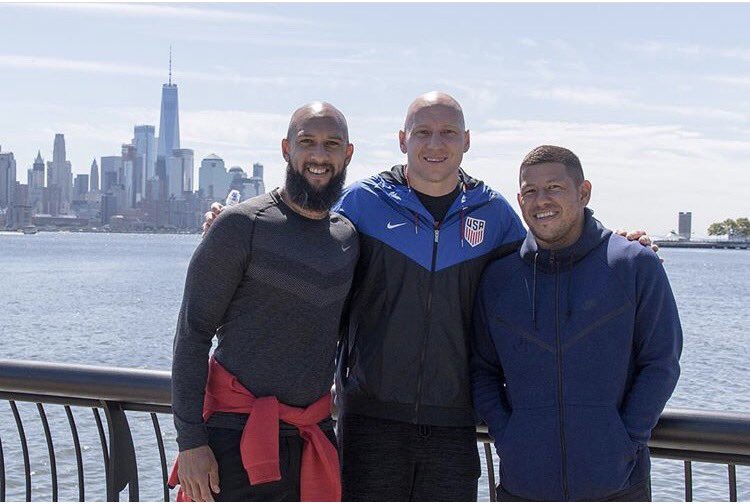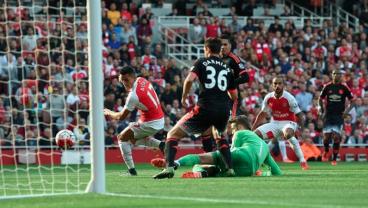Alexi Lalas brought it up; we’re here to answer it. Is Tim Howard still the right man in goal for the U.S. Men’s National Team?
Three years ago Tim Howard was the meme king of the World Cup, dual-handedly keeping Belgium at bay for 90 minutes while his USMNT teammates flailed around defensively. Howard made a World Cup record 15 saves that day, ultimately allowing two goals in extra time in a 2-1 loss that would have been a 1-0 win had Chris Wondolowski been able to put a shot on target from six yards out.
After that match, Howard took a break from national team play, not appearing for the States for more than a year. While Howard has since come back into the fold, the question remains: Is he the best man for the job? Is the 38-year-old still the best American goalie? Should Howard be benched?
Lalas bashed Tim Howard (and many others) in an on-air tirade when he was supposed to be commentating on an MLS match on Sunday night. He implied Howard hasn’t made a save since that 2014 World Cup match against Belgium, saying “Tim, the Belgium game ended three years ago, we need you to save the ball now.”
Howard has, in fact, made a save since the 2014 World Cup. Nearly 300 of them, in fact, including 39 for the national team. Howard’s averaged 2.73 saves per match since the Belgium loss. He has 39 saves in 16 matches for the U.S.
But Howard has been on a decline since the 2014 World Cup, at least statistically.
During the 2013-14 season leading up to the World Cup, Howard was brilliant. He made 112 saves (3.03 saves per match) leading Everton to a fifth-place finish in the Premier League. Howard allowed one goal per game and recorded 15 clean sheets. With the national team, he made 46 saves in 15 matches (3.07 spm).
He peaked at the World Cup. In the USMNT’s four matches, he made 28 saves. While obviously aided by the 15-save game against Belgium, he still averaged 4.33 saves per match in the group stage. Howard was a major reason the U.S. managed to escape the group of death and reach the Round of 16.
Since then, Howard’s numbers have declined.
Immediately following the World Cup, while on hiatus from the national team, Howard’s saves and clean sheets were nearly cut in half, dipping to 65 and 15, respectively. Everton struggled too, falling to 11th in the league. The story was the same the following season. The Toffees finished 11th and Howard allowed 1.4 goals per match, nearly half a goal more than his 0.96 goals-per-game average in his English Premier League career.
It was at this point Howard returned to Major League Soccer, joining the Colorado Rapids for the 2016 season. While his goals-per-game averaged dipped to 1.12 that year aided by coach Pablo Mastroeni’s defensive drilling, he made just 3.18 saves per game, compared to his 5.84 average with the MetroStars before going abroad. This year his saves per game are down to 3.11.
The numbers are starker with the national team. After recording seven saves per game in 2014-15 (all during the World Cup), when he returned for the 2015-16 season he managed 3.25 saves per game. The following year the saves fell to 2.38 and this season they’re at an astonishing 1.75. (Admittedly it’s a small sample size and it’s actually not a career low.)
Grading a goalkeeper is difficult work; stats alone can’t tell the story. If a goalie gives up a lot of goals, it could be that his defense is really bad or it could be that he needs a new contact prescription. If he makes a lot of saves, it could be that he’s a great goalie or maybe the opponents think they can score from anywhere on him. Conversely, a good goalie can get in the head of opponents and make them feel they need the perfect opportunity before even attempting a shot.
But this sharp decline at both club and international levels in recent years shows Howard is no longer the heroic goalie he once was. Is he still the best for the U.S.?
A couple years ago it would have been easy to say no. Brad Guzan was still in the Premier League bending over backwards trying to keep some pretty poor teams out of the relegation zone. Guzan is the latest in a long line of successful, bald, American goalies playing in the Premier League, but he too fell out of favor in England and returned to Major League Soccer, where he now plays for the expansion Atlanta United. Guzan averaged 3.06 saves per match in England and 3.65 in MLS with Chivas USA before that. This year he is averaging 2.57 saves with Atlanta (granted a small, seven-match sample size).

Who would you choose? Photo: @YULANDAJONES | Twitter
Nick Rimando is typically the third-choice goalkeeper for the USMNT, both under Jurgen Klinsmann and Bruce Arena. But Rimando is 38 and often chosen more for his leadership abilities than shot-stopping abilities.
After Rimando there’s a mixture of youthful and experienced goalies that could be called upon. Bill Hamid and Sean Johnson are solid keepers, but not exactly setting the world on fire with D.C. United and New York City FC, respectively. William Yarbrough probably deserves more of a chance given he chose to play for the U.S. over Mexico, the country of his birth.
Ethan Horvath, 22, is the only recent U.S. call-up who is playing goalie abroad (for Club Brugge in Belgium), but he probably isn’t ready to take over the No. 1 jersey. Same for Jesse Gonzalez, also 22, who played for Mexico in youth competitions before switching allegiances to the U.S. and is another player to watch.
But for now? Howard may still be the best the U.S. has.
For decades the USMNT has been buoyed by a long line of successful goalies like Tony Meola, Brad Freidel and Kasey Keller. That well appears to be drying up. So for the time being, Tim Howard is probably still the Americans’ best bet in goal.

 Home
Home




